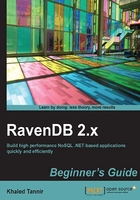
From relational databases to RavenDB
Developers and database administrators with a background on working with relational database systems will quickly recognize the similarities between the logical abstractions of the relational data model and the RavenDB data model. The next figure gives a quick view of a relational data model and their equivalent with those of the RavenDB data model:

Note
A Document in RavenDB will typically contain data from multiple tables in a Relational Database Management System (RDBMS).
When you work with RavenDB, you need to consider that RavenDB is non-relational. The reason is that RavenDB treats each document as an independent entity. There are no foreign keys in a collection and as a result, there are no JOIN queries. Constraint management is typically handled in the application layer. Also, because of its flexible schema property, there is no need for the expensive ALTER TABLE statement in RavenDB and you can have user defined content much more easily.
RavenDB is able to store large amounts of data and also is able to optimize the way documents are stored and managed. It supports Horizontal scaling and each document can be stored on any node of the horizontal resource pool (this is called sharding).